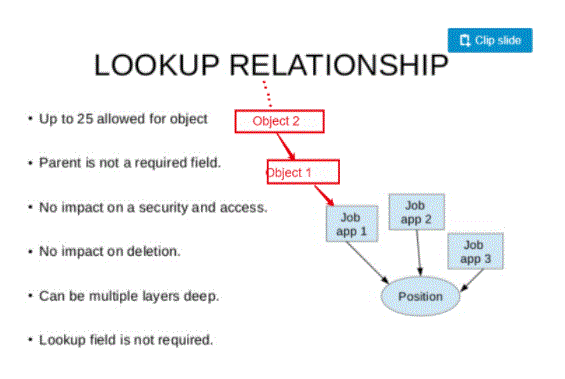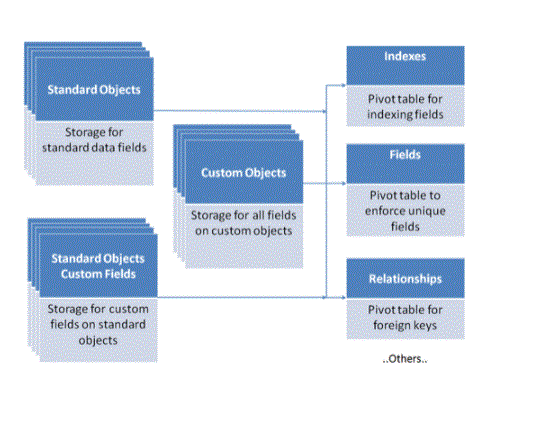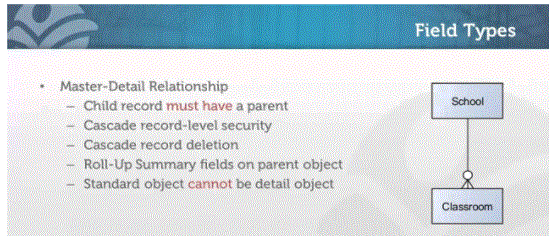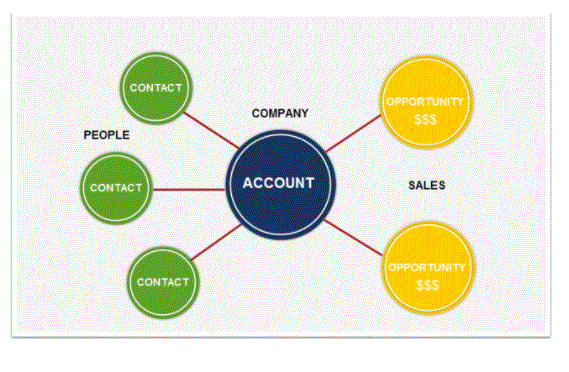
Salesforce Lookup Relationship : Expert’s Top Picks | Everything You Need to Know
Last updated on 17th Dec 2021, Blog, General
A lookup relationship essentially links two objects together so that you can “look up” one object from the related items on another object. Lookup relationships can be one-to-one or one-to-many.
- Introduction to Salesforce Lookup Relationship
- Understanding Lookup Relationships
- The 6 Types of Relationships in Salesforce
- Creating External Lookup Relationships
- How to Use the Lookup Relationship in Salesforce
- Lookups vs. Master-Detail Relationships
- It’s behaviour
- When you create a lookup relationship, you can set these options
- Problem with Lookup Relationships
- Conclusion
Introduction to Salesforce Lookup Relationship:
A look relationship involves finding a field worth supporting the worth in associate degree other fields in an item. it’s wide utilised in the case of knowledge that is sometimes shared between 2 objects.
For example:
At the traveller company, we’ve got a delivery location that ought to be associated with the delivery schedule. therefore we’ve got a “DeliverySchedule” field within the delivery item that appears at costs from another Custom Object known as “Delivery System”. currently let’s scrutinise the steps to form such a watchful relationship.
Step 1
First we tend to determine the objects and fields that require to be connected. In our example, these 2 things square measure the Delivery arrange and also the Delivery space.
Step 2
Create a Custom Object known as DeliveryLocation as we tend to die within the previous chapter. In it, visit the tab fields and relationships. Click New → Custom Field → See Relationships. choose the sector sort because the viewpoint and enter the main points as shown below.
Step 3
You can verify the viewing relationships created by attending to the schema builder and choosing 2 things to show. Lookup could be a variety of Salesforce relationships that connect 2 things along while not compromising security and removing buildings. making social relationships is feasible by adding visual relationships to common, cultural and external factors.

- The observation relationship field connects the child object with the parent object. Relationships can be added to the general, external and custom features of children’s records; and general and custom items for parent records.
- The child’s record with a viewing relationship contains a viewing icon that, when clicked, shows its parent’s record. Conversely, when a parent’s record viewer is viewed, users are able to view the related list of the child’s records under it.
- Check fields are not automatically needed, as in the case of key details and relationships to more. The security and accessibility of visually connected devices is not affected by each other. One item can be removed, while the other remains intact. Linked items can be accessed separately or collaboratively. This is to protect data from accidental editing and deletion.
Understanding Lookup Relationships:
- Looking for a freely connected relationship, that permits you to attach one factor to a difference in a method or another.
- In this example, you’ll see that Inheritance could also be concerned in an exceedingly few cases. During this case, if the case is fired, the Inheritance can stay and the other way around.
The 6 Types of Relationships in Salesforce:
The data relationship between the things in Salesforce will be a difficult topic to induce your head around. you will be round-faced with a business scenario that needs making a custom, then successive calls are what reasonable relationships you must use to expand your Salesforce knowledge model. This is a basic plan to find out, as you create positivity you select the proper kind of relationship that guarantees a quick knowledge model. Let’s immerse ourselves.
1.Look for Relationships
2.Master-Detail Relationship
Key knowledge relationships are tightly sure relationships, which suggests if the parent is removed, therefore at the child’s records. This can be an honest factor and may be unbelievably useful.
This relationship appears shuddery, however it shouldn’t be! Master-detail conjointly permits the parent record to regulate the child’s record options like sharing and visibility. no matter parental security protection you select, the child’s record is transmitted.
In this example, you’ve got an inventory of rooms wherever workers will book. However, if the space is to be removed, however, can the conferences be used? Nothing, in order that they go too. However, once you produce a key detail relationship, you’ll choose a box to permit you to boost the youngsters to be kind and allow them to opt for a brand new room!.
A great place for Master info sharing is that you simply will produce rollup outline fields! Note, one item will have a pair of key knowledge relationships.
3. A lot of Relationships And a lot of
It says you’ve got a scenario where you would like to own tonnes of records associated with several others. Continuing that field of viewing a number of times for every item isn’t the simplest observation and can be worse. This can be wherever we should always use Junction Objects.
In the image below, we have a tendency to see that a session will have several speakers however conjointly speakers will give in several sessions. a good place to feature a ‘Time Speaker’ part in between to manage this relationship!
4.Your Relationships
Suppose, for instance, you’ve got a Campaign. This campaign is a component of a bigger campaign. you’ll use the check field from campaign to… campaign! Why? this is able to be a good chance to indicate what number children’s campaigns relate to the most parent campaign (known as Campaign Hierarchy).
5. External relationships
There are 2 extra varieties of external process that we should always concisely cover:
Indirect wanting relationships: Enable relationships to create between a Salesforce object and an external object. If your Salesforce org were family, things would be connected however to not identical families. an honest example that relates to account payment records from the ERP system – the ERP system is outside of Salesforce however the records are necessary. however they relate to AN external ID to match payments with an account.
External-looking relationships: Enable relationships to create between 2 external objects. 2 of your friends outside your cluster are currently in an exceedingly good relationship. Maybe that ERP system links payment records with a checking account.
6. Hierarchical relationships
Simple however typically unnoticed relationships at Salesforce imitate. This distinctive relationship will solely be applied to a user object and is intended to make a user class. for instance, it will be accustomed produce a user object read field, which might be accustomed list user manager.

- Navigate to Setup.
- Select Upgrade, then click External things.
- Select Order Details.
- Find the order odeID field. Click Edit, then click amendment Field kind.
- Select the external viewing relationship as its knowledge kind. Click Next.
- Select Orders beneath Value-Related.
- Type eighteen below field length. Leave some choices for his or her default values.
- Click Next.
- f the sectors are visible altogether, tick the box next to Visible. Click Next.
- A few checkboxes can seem. don’t edit them. they must keep their default values.
- Click Save.
- Note that new order details connected listings seem at rock bottom of the Order page. External search relationships are a unit currently engineered between OrderDetails and therefore the OrderID field.
Creating External Lookup Relationships:
This example links one thing to Associate in Nursing external object. Here area unit the steps to try to to it:
How to Use the Lookup Relationship in Salesforce:
Lookup is a type of Salesforce relationship that connects two things together without compromising security and removing buildings. Creating interpersonal relationships is possible by adding visual relationships to common, cultural and external factors.
Understanding Relationships to look at.
The observation relationship field connects the child object with the parent object. Relationships can be added to the general, external and custom features of children’s records; and general and custom items for parent records.
The child’s record with a viewing relationship contains a viewing icon that, when clicked, shows its parent’s record. Conversely, when a parent’s record viewer is viewed, users are able to view the related list of the child’s records under it.
Check fields are not automatically needed, as in the case of key details and relationships to more. The security and accessibility of visually connected devices are not affected by each other. One item can be removed, while the other remains intact. Linked items can be accessed separately or collaboratively. This is to protect data from accidental editing and deletion.

- A tightly certain record with an instantaneous dependence between 2 objects. It may also be delineated as a parent-child relationship.
- A record record can not be created while not associated with a professional.
- Sharing rules are unit heritable from the master to the record record.
- We are a unit unable to update the connection to the master with the key knowledge relationship.
- The number of key knowledge relationships that may be used is restricted to two.
- Big knowledge relationships are a unit mechanically added to the report record varieties.
- We are unable to line profile object permissions for an in depth record.
- If the first record is deleted then the record of its details is additionally deleted at the side of it, that is, it is used to delete the cascade.
- Roll-Up outline may be created with key details.
- This type of relationship may be used after we simply ought to have a relationship between 2 things however not an instantaneous dependence on one another.
- This is a loose-knit relationship.
- These area units are accustomed to consult with ordinarily distributed knowledge, like index knowledge.
- The maximum variety of observation relationships within the field is concerning forty.
- They are accustomed to link 2 things along after we don’t need to own behavioural details like sharing rules, profile permissions, and cascade deletions.
- Tracking is employed after we ought to associate multiple ‘parents’ with an in depth record.
- Parental removal mechanically deletes the child-related field however not the whole record.
- This type of relationship is additionally just like relationships between multiple individuals.
Lookups vs. Master-Detail Relationships:
Master-Detail Relationship:
Viewing relationships:
- Deleting a child’s record takes it to the Recycle Bin and leaves the primary record complete, meaning that when the child’s record is deleted, its primary record is not deleted. But deleting the primary record also deletes related child records.
- Deleting the deletion of the child’s record restores it, and terminating the deletion of the primary record also removes the related child records, meaning deleting the primary record restores both the primary record and its children’s records. However, if you delete the child’s record and later, separately, delete its primary record, you cannot stop deleting the record, as it no longer has the primary record to which it belongs.
- By default, records cannot be re-created in key data relationships. It means that the parents of the child’s record cannot be changed, once it has been provided and stored. However, Administrators may allow children’s records in key data relationships to be customised to separate parental records by selecting the option to allow editing in the details of the big data relationship.
- Children’s records as an inheritance of security settings and permissions from the primary record. You cannot set permissions on a child’s record in the key data relationship independently.
- The key data relationship field (which is the link field) is required for setting the child’s record page. Each custom item can have up to 25 details and up to 25 details.
- Parent and child records have their own settings for sharing and security in a surveillance relationship.
- If the parent’s record in the custodial relationship is deleted, tracking the child’s history of the child’s record does not record the deletion. For example, if a parent’s account has been deleted, the list of accounts associated with the child’s account does not reflect the deletion.
It’s behaviour:
Relationship of professional information:
Viewing relationships:
- Clear the worth of this field: this is often the default. Deleting a field wherever the sector doesn’t ought to contain a worth from the connected viewing record.
- Don’t enable the removal of the viewing record that’s a part of the watch relationship: If you’ve got a reliance on the watch relationship, this feature doesn’t enable the chase record to be removed.
- Delete this record again: this feature is mechanically closed and one should contact Salesforce support to alter this feature.
An important purpose to stay in mind here is after you produce a replacement custom field or edit an existing one, there’s a locality known as ‘What to try to do if the search record is deleted?’ With many radio buttons as follows:
- Clear the worth of this field (this possibility isn’t obtainable once the sector is required)
- Don’t enable the removal of the viewing record that’s a part of the watching relationship
- Delete this record (this possibility skips security and sharing settings, that is why it mechanically shuts off and somebody has Salesforce contact support to alter this feature.)
- Sometimes you’ll notice that this class is missing from a number of the menus to line up their read fields. The ‘What to try to do if the read record is deleted?’ Section won’t be a gift within the reading configuration if the article you’re viewing is the same as that open view. You can build relationships from AN object to its own, it suggests that a private relationship, however it’s to be a relative relationship, and one record can’t be connected to that. However, the record will associate itself with it indirectly.
When you create a lookup relationship, you can set these options:
Make the viewing space necessary to save lots of the record, that additionally needs a standardised page layout. If the check field is voluntary, you’ll be able to specify one in every of the 3 behaviours that has to occur if the viewing record is deleted:

- No tight binding.
- If we add a new agent >> and do not select a manager, we can save it.
- If the Manager’s record is deleted, there is no effect on the agent’s record.
- With a viewing relationship, communication / bonding between two things is not possible.
Problem with Lookup Relationships:
Conclusion:
Learning about the different types of relationships in Salesforce and when they are used, is an essential part of any professional career. Hopefully, this article has given you a complete overview of the relationship, and when it is being used.
The relationship of the big data and the relationship of the observer, we must ensure that there are no summarising fields in the main object. If there are rollup shortcut fields we must remove those areas in order to convert them. Deleted Wrap Fields should also be permanently deleted. This can only be done in Salesforce Classic as ‘Deleted Fields’ does not appear in Lightning.
To change the focus on big data relationships you need to provide parental records on all children’s records. Only you can turn the viewing relationship into a key data relationship if the check field in all records contains a value.
Observation relationships actually connect two things together to “look up” one thing in relation to another thing. Viewing relationships can be between one or more to many.
